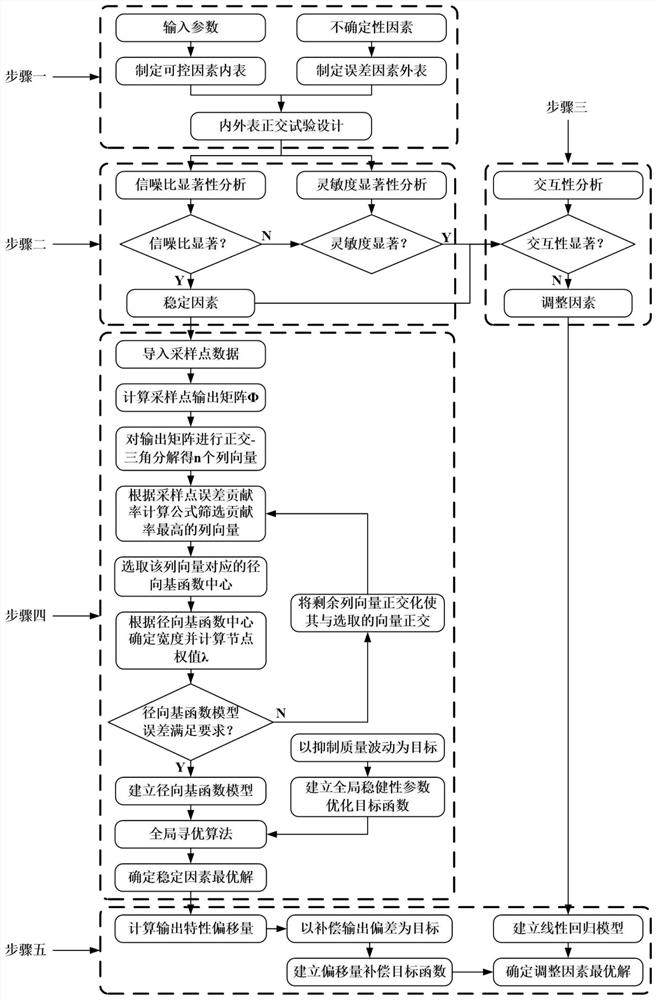A Quality Consistency Design Method for Electromagnetic Relay Based on Orthogonal Least Squares
An electromagnetic relay and least squares technology, applied in computer-aided design, instrumentation, calculation, etc., can solve problems such as low optimization accuracy, inability to eliminate program robustness, and inability to determine the global optimal solution, so as to improve modeling accuracy, The effect of reducing the number of modeling parameters
- Summary
- Abstract
- Description
- Claims
- Application Information
AI Technical Summary
Problems solved by technology
Method used
Image
Examples
specific Embodiment approach 1
[0021] Specific implementation mode 1: This implementation mode records a method for designing electromagnetic relay quality consistency based on orthogonal least squares, and the method includes the following steps:
[0022] Step 1: Determine the input parameters and uncertainty factors according to the research object and optimization goal, and carry out the orthogonal experiment design of the inner and outer surfaces; among them, the input parameters are arranged in the inner table, and the uncertainty factors are arranged in the outer surface, according to the input characteristics and the number of uncertain factors and the number of levels respectively select the inner and outer orthogonal tables and determine the test plan; the research object is a relay, and the optimization goal is determined according to the actual situation, which can be the armature pull-in speed, the magnetic retention force, etc.; the input parameters can affect the optimization The size of each k...
specific Embodiment approach 2
[0029] Specific embodiment two: a kind of electromagnetic relay quality consistency design method based on orthogonal least squares described in specific embodiment one, in step three, the described decoupling of parameters is specifically: select any from the input parameters For the non-repetitive combination of two parameters (X, Y), first calculate the changes Δx and Δy of the corresponding output characteristics when the parameters X and Y change independently, and then calculate the change of the corresponding output characteristics when the combination of (X, Y) changes at the same time Quantity Δxy, if parameter X and parameter Y are completely independent, the mathematical relationship of Δxy=Δx+Δy should be satisfied, otherwise, it means that there is an interaction between parameter X and parameter Y;
[0030] Define the interaction factor γ to reflect the degree of interaction between parameters X and Y, and use the following formula to determine the interaction bet...
specific Embodiment approach 3
[0033] Specific embodiment three: a kind of electromagnetic relay quality consistency design method based on orthogonal least squares described in specific embodiment one, in step five, described adopts the linear regression method to establish the polynomial between the adjustment factor and the output characteristic The function is specifically: after the optimization scheme of the stability factor is determined, the output characteristics will deviate with the change of the parameter value, first calculate the offset ΔF of the output characteristics s , and then jointly adjust the factor polynomial F a , to establish the offset compensation target H 2 , as shown in the following formula:
[0034]
[0035] Since the adjustment factor and the stability factor are independent of each other, the output offset can be quantitatively compensated without affecting the robustness of the scheme, and finally the adjustment factor X a design plan.
PUM
 Login to View More
Login to View More Abstract
Description
Claims
Application Information
 Login to View More
Login to View More - R&D
- Intellectual Property
- Life Sciences
- Materials
- Tech Scout
- Unparalleled Data Quality
- Higher Quality Content
- 60% Fewer Hallucinations
Browse by: Latest US Patents, China's latest patents, Technical Efficacy Thesaurus, Application Domain, Technology Topic, Popular Technical Reports.
© 2025 PatSnap. All rights reserved.Legal|Privacy policy|Modern Slavery Act Transparency Statement|Sitemap|About US| Contact US: help@patsnap.com



